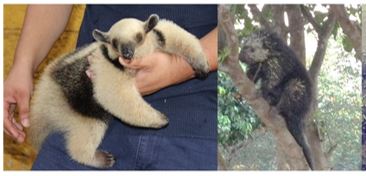Abstract
We present notable records of golden opossum (Caluromys derbianus), anteater (Tamandua mexicana), and porcupine (Coendou mexicanus), three cryptic species, with arboreal habits considered cared for in Mexico, whose presence in Oaxaca is historical or scarce. The record of golden opossum was obtained through photo-trapping and the records of porcupine and anteater through reports from local inhabitants. The golden opossum was recorded in a fragment of tropical evergreen forest, while the records of the other two species occurred in agricultural areas, but close (<3 km) to patches of secondary vegetation of tropical evergreen forest, the areas were equal or greater 0.97 km2. These records increase the knowledge of the presence of these species in the north of Oaxaca. The records indicated the tolerance of the anteater and porcupine to anthropized landscapes, and may highlight the type of risks they may face from being run over and captured.
References
Arriaga, L., et al. (coords.) 2000. Regiones terrestres prioritarias de México. Comisión Nacional para el Conocimiento y Uso de la Biodiversidad, México.
Briones-Salas, M., et al. 2015. Diversidad y distribución geográfica de los mamíferos terrestres del estado de Oaxaca, México. Revista Mexicana de Biodiversidad 86: 685-710.
Bucher, J. & Hoffman, R. 1980. Caluromys derbianus. Mammalian Species 140: 1-4.
Cuarón A. 2005. Oso hormiguero. Pp. 121-123. en Los mamíferos silvestres de México (Ceballos, G. & G. Oliva. eds.), Fondo de Cultura Económica y CONABIO. México.
Espinosa-Lucas, A., et al. 2015. Tres nuevos registros en la zona de influencia de la Reserva de la Biosfera Tehuacán-Cuicatlán, Oaxaca. Therya 6: 661-666.
GBIF. Caluromys dervianus. (En línea) 2019a [acceso 14 enero 2016] https://doi.org/10.15468/dl.tquqrs
GBIF. Tamandua mexicana (En línea) 2019b [acceso 14 enero 2016] https://doi.org/10.15468/dl.bfgpxv
GBIF. Sphiggurus mexicanus (En línea) 2019c [acceso 14 enero 2016] https://doi.org/10.15468/dl.pela9f
Goodwin G.G. 1969. Mammals from the State of Oaxaca, Mexico, in the American Museum of Natural History. Bull Am Mus Nat Hist. 141: 1-270
IBUNAM. Coendou mexicanus (Kerr, 1792), ejemplar de: Colección Nacional de Mamíferos (CNMA). (En línea). 2019. [acceso 28 enero 2019] URL http://datosabiertos.unam.mx/IBUNAM:CNMA:35001
INEGI. 2009. Prontuario de información geográfica municipal de los Estados Unidos Mexicanos.
INEGI. 2015. Mapa de uso de suelo y vegetación serie V, escala 1:250:000. INEGI.
IUCN (International Union for Conservation of Nature). Red List of threatened species. (En línea) 2018. [acceso 14 diciembre 2018] URL: www.iucnredlist.org.
Juárez J. 2005. Puerco espín. Pp. 811-812. en Los mamíferos silvestres de México (Ceballos, G. & G. Oliva. eds.), Fondo de Cultura Económica y CONABIO. México.
Lira-Torres, I., et al. 2012. Mamíferos de la Selva Zoque, México: riqueza, uso y conservación. Rev Biol Trop. 60(2): 781-797.
Lorenzo, C., et al. 2014. Causes and consequences of change rates in the habitat of the threatened tropical porcupine, Sphiggurus mexicanus (Rodentia: Erethizontidae) in Oaxaca, Mexico: implications for its conservation. Rev Biol Trop. 62(4): 1481-1494.
Medellín R. 2005. Tlacuache lanudo. Pp; 102-103 en Los mamíferos silvestres de México (Ceballos, G. & G. Oliva. eds.), Fondo de Cultura Económica y CONABIO. México.
Monje-Nájera, J. 2018. Road kills in tropical ecosystem: a review with recommendations for mitigation and for new research. Rev Biol Trop. 66(2): 722-738.
Navarrete, D, & Ortega, J. 2011. Tamandua mexicana (Pilosa: Myrmecophagidae). Mammalian Species 43(874): 56-63.
Peña-Mondragón, J. & Castillo. A. 2013. Depredación de ganado por jaguar y otros carnívoros en el noreste de México. Therya 4: 431-446
SEMARNAT. 2010. Norma Oficial Mexicana NOM-059-ECOL-2010. Protección ambiental, especies de flora y fauna silvestres de México, categorías de riesgo y especificaciones para su inclusión, exclusión o cambio, y lista de especies en riesgo.
Solari, S. & Lew, D. 2015. Caluromys derbianus . The IUCN Red List of Threatened Species 2015: e.T3650A22175821. https://dx.doi.org/10.2305/IUCN.UK.2015-4.RLTS.T3650A22175821.en. Downloaded on 14 October 2016.
Torres, R., Tamburini, D., Lescano, J. y Rossi, E. 2017. New records of the Endangered Chacoan peccary Catagonus wagneri suggest a broader distribution than formerly known. Oryx, 51 (2): 286-289. DOI: https://doi.org/10.1017/S0030605315001404
Trejo I. 2004. Climas. Pp. 67-85, en: Biodiversidad de Oaxaca (García-Mendoza, A. et al. eds.). Instituto de Biología, UNAM-Fondo Oaxaqueño para la conservación de la Naturaleza-World Wildlife Found. México.

This work is licensed under a Creative Commons Attribution-ShareAlike 4.0 International License.






